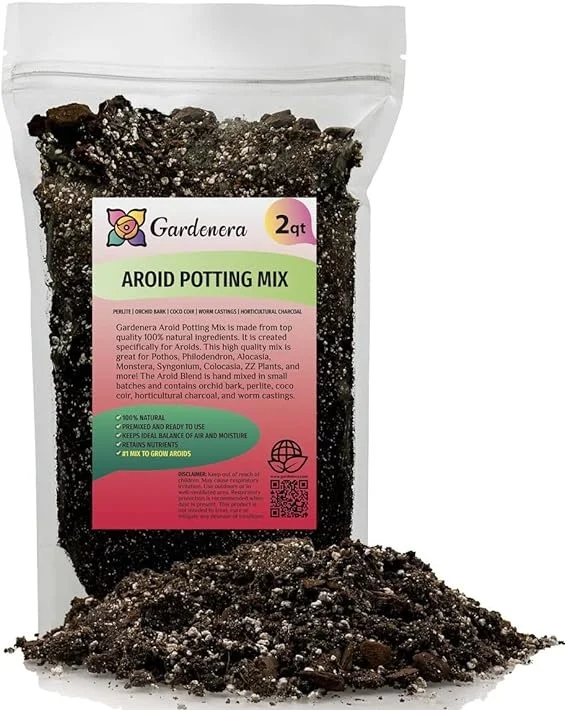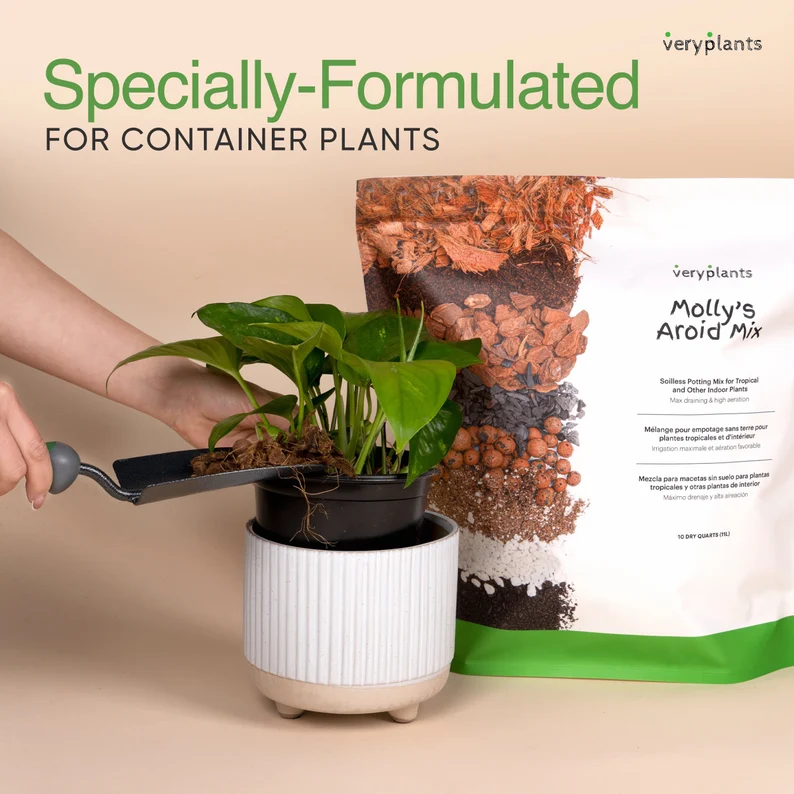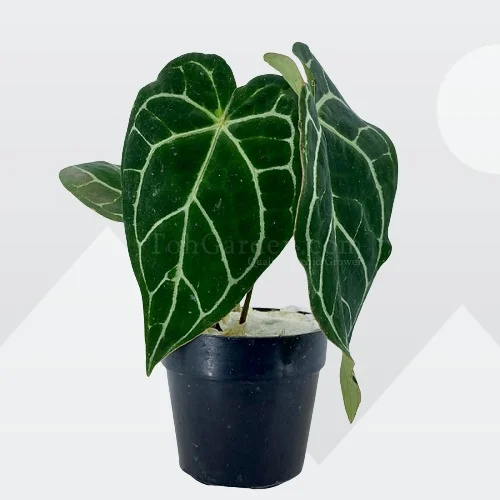How to Grow and Care for Anthurium metallicum Indoors
Some links in this post may be affiliate links
Anthurium metallicum prefers bright indirect light, moderate warmth, highly humid conditions and consistently moist, rich, chunky aroids soil coupled with monthly feeding in the growing season.
Anthurium metallicum is one of the popular Anthurium varieties on account of its large, velvety, dark-green almost black leaves with distinct veining and a beautiful metallic appearance in bright light.
The inflorescence is dark-pink to red and is about 15-20 cm long. Due to these characteristics, Anthurium metallicum is an outstanding addition to any plant collection and is sought-after by many plant enthusiasts.
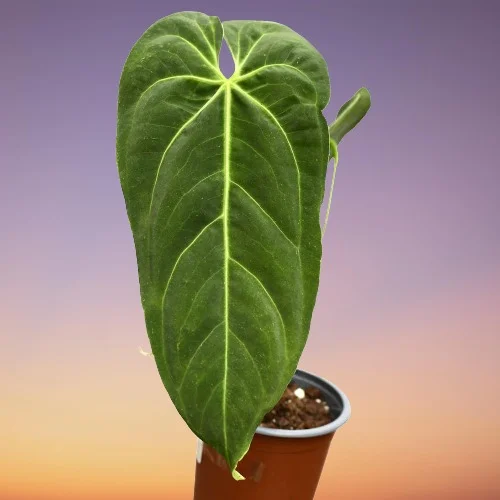
Botanical name: Anthurium metallicum
Family: Araceae
Origin
Anthurium metallicum is native to Columbia where it is found growing erect or semi-erect in ravines or along the border of trails.
Size
Anthurium metallicum grows to a height of 6 feet with a spread of 3-5 feet. The leaves can be over 4 feet long with a beautiful velvety sheen making it one of the best large low-light plants for the living room where it will provide a magnificent sight.
Toxicity
Anthurium metallicum like other Anthuriums is toxic to both humans and pets. It is considered to contain oxalate crystals which can cause digestive distress, breathing problems and skin irritation. Always wear gloves when handling this plant and wash your hands thereafter.
Where to Buy
Anthurium metallicum is an excellent plant for any houseplants collection. Check them on Etsy Link to Etsy).
Anthurium metallicum Indoor Care Guide
This guide will cover everything from watering and light requirements to propagation methods and troubleshooting common issues. Anthurium metallicum blossoms in bright indirect light (filtered light), average warmth of 16-280C, humidity of 60-80% and consistently moist, fertile, well-drained, aroids potting soil coupled with monthly feeding during the growing season.
Anthurium metallicum requires pruning to keep it neat and also minimize pest and disease infestations. Repotting is only needed when it outgrows its current pot. Keep reading for more on these growing conditions and how to achieve them.
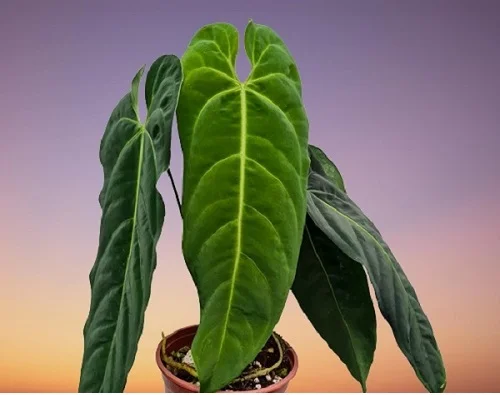
Watering
Water Anthurium metallicum thoroughly during the growing season and allow the top 1-2 inches of soil to dry out between waterings to keep soil consistently moist.
Cut down on watering in the cold season as growth is reduce at this time. Maintain the soil slightly moist but do not allow the soil to dry out completely to avoid crispy leaf edges and brown leaf tips.
Ascertain that the pot has a drainage hole to prevent the soil from getting soggy as it can lead to yellowing leaves and root-rot and eventual plant death.
Light Requirements
Anthurium metallicum grows best in bright indirect light away from direct sunlight as it can scorch the leaves. A curtain-filtered sunny window is perfect for this plant.
This plant naturally grows under the canopy of rainforests, meaning direct sunlight can cause leaf burn, while too little light can slow its growth.
If the leaves become dull and small, it might not be getting enough light. Move it closer to a well-lit window or instal a grow light where the natural lighting is not adequate.
Rotate the pot frequently to ensure that the plant receives light on all sides for uniform growth to prevent unbalanced growth.
Temperature and Humidity
Anthurium metallicum requires consistent warmth within the range of 16-280C. Keep it away from cold and hot drafts originating from draft windows, windy doors, air conditioning units, heaters and others to avoid sudden changes in temperature. Abrupt temperature flacuations can result in reduced and leaf drop.
Anthurium metallicum flourishes in humidity of 60-80%. To step up humidity, set the pot on a wet pebble tray or use a cool mist humidifier.
Clean the leaves occasionally by damp-wiping with a soft cloth to get rid of dust. Do not leave water drops on the leaves as it may cause fungal infestations.
Potting Soil
The best potting soil for Anthurium metallicum is a fetile, aerated, well-draining potting mix that mimics its epiphytic environment. Most potting mixes designed for Aroids are ideal for this plant. You may add charcoal to the mix to prevent fungal growth and keep the roots healthy.
Fertilizer
Feed Anthurium metallicum every 4 weeks during the growing period with a balanced, liquid fertilizer. Minimize or stop feeding in the cold season as growth is minimal and feeding at this time can lead to fertilizer burn.
To prevent yellowing or brown leaf tips, occasionally flush out accumulated salts from the soil. Do this by running a stream of water through the soil until the water comes out through the drainage hole. Allow it to run for a few minutes and repeat the process several times.
Repotting
Repot Anthurium metallicum every 1-2 years at the beginning of the growing season. Use a pot one-size larger and free-draining soil that is rich in organic matter.
Make sure that the pot has a drainage hole to prevent the soil from getting soggy as it can lead to root-rot. Check out these ceramic planters with drainage hole on Amazon.
Pruning
Pruning Anthurium metallicum is easy. Remove yellow and dead leaves to maintain the plant neat and also reduce pest and disease infestations.
Cut the leaves at the base of the stem with a sharp sterlized knife or a clean pair scissors to avoid unnecessary injuries which can lead to fungal disease infestations.
Propagation
Anthurium metallicum can be propagated during the growing season (spring and summer) by plant divison, air layering, and stem cuttings which can be rooted either in water or in soil.
Learn more on how to propagate Anthurium metallicum in 4 easy ways
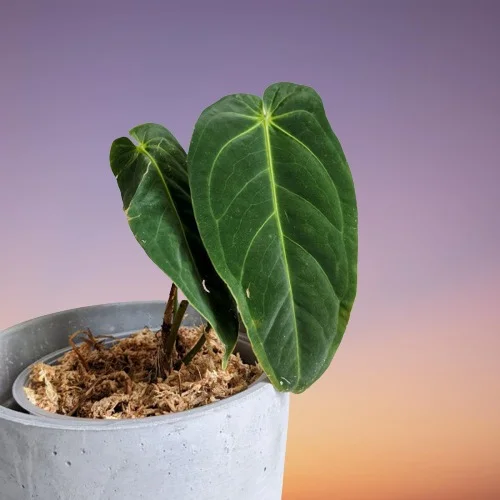
Anthurium metallicum Common Problems
Anthurium metallicum common problems include yellow leaves, pests, diseases, brown leaf tips, leaf spots, drooping leaves among others. Keep reading for more on these problems, their remedies and solutions.
Yellow leaves
One of the causes of yellow leaves in Anthurium metallicum is soggy soil. Keep the soil moist but not soggy by ensuring that the pot has a drainage hole and that the soil is free-draining.
Another cause of yellow leaves in Anthurium metallicum is cold drafts (cold air). Protect it from cold drafts or place it away from windy doors and windows.
Pests
The common pests in Anthurium metallicum are spider mites, aphids and fungus gnats. Isolate the affected plant to prevent spread to other plants and treat it with neem oil or insecticidal soap to get rid of the pests as per the manufacturer's recommendations.
Diseases
Anthurium metallicum is prone to root-rot disease which is prevalent in soggy soil. Keep the soil moist but not soggy by ensuring that the pot has a drainage hole and that the soil is free-draining.
Brown leaf tips
Two reasons are responsible for brown leaf tips in Anthurium metallicum. One reason for brown leaf tips is that the air is too dry. Set the pot on a wet pebble tray or use a cool mist humidifier to raise humidity or grow the plant in the humid areas in the home.
The second reason for brown leaf tips in Anthurium metallicum is soggy soil. Maintain the soil moist but not soggy by ensuring that the pot has a drainage hole and that the soil drains easily.
Drooping leaves and stems
There are four causes of drooping leaves and stems in Anthurium metallicum. The first cause of drooping leaves is low humidity. To increase humidity, set the pot on a wet pebble tray or grow the plant in the bathroom and other moist areas in the home.
The second cause of drooping leaves and stems in Anthurium metallicum is incorrect watering; either underwatering or overwatering. Maintain the soil consistently moist during the growing season and never allow the soil ball to dry out completely. Read more on how to water indoor plants the right way.
The third cause of drooping leaves and stems in Anthurium metallicum is too high temperature due to exposure to direct sunlight. Protect the plant from direct sunlight by filtering the light with a sheer curtain.
The fourth cause of drooping leaves and stems in Anthurium metallicum is pests and diseases infestation. Inspect the plant and take timely control measures to get rid of these pests.
Brown leaf spots
The brown leaf spots are sunburn marks in Anthurium metallicum are caused by exposure to direct sunlight. Move the plant to a shaded place or use a curtain to filter the light.
Related: 8 Common Anthurium Problems and How to Fix Them
Conclusion
Anthurium metallicum is a breathtaking tropical plant that requires high humidity, bright indirect light, and well-draining soil to thrive. With proper care and propagation, you can expand your collection and enjoy its striking foliage for years to come.
Frequently Asked Questions
1. How often should I water Anthurium metallicum?
Do not water on a schedule. Check the soil moisture in the top 1-2 inches before watering. If it feels dry water the plant. If it feels wet do not water, wait a few more days until the soil is dry.
2. Can Anthurium metallicum grow in low light?
No, Anthurium metallicum needs bright, indirect light for optimal growth. If the light is too low the plant growth will reduce drastically and may result in death if not corrected.
3. Is Anthurium metallicum toxic to pets?
Yes, Anthurium metallicum contains calcium oxalate crystals, which are toxic to cats and dogs if ingested. Keep it out of reach of cats and dogs.
4. When is the best time to propagate Anthurium metallicum?
The best time to propagate Anthurium metallicum is in spring and summer, as the plant is actively growing.
5. Do I need a humidifier for Anthurium metallicum?
Yes, if the humidity falls below 60%, you will need a humidifier to maintain the optimal conditions for growth.
You liked it? Share on social media.
Related Content
Amazon Associates Disclosure
Homeplantsguide.com is a participant in the Amazon Services LLC Associates Program, an affiliate advertising program designed to provide a means for sites to earn advertising fees by advertising and linking to amazon.com.
